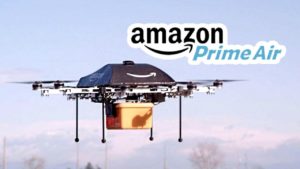(Source: The Guardian)

Paul Misener, Amazon’s vice-president of global public policy, told a congressional hearing this week that his company would be ready as soon as all the rules were in place – but Misener gave no hints as to what that would look like beyond joking with a congressman that there was a basket of fresh fruit on the way to his doorstep to demonstrate the technology’s viability. (An Amazon staffer told the Guardian the company “won’t launch Prime Air until we are able to demonstrate safe operations”.)
The Federal Aviation Authority (FAA) will finally have regulations governing the commercial use of unmanned aircraft by June next year. But the technology has a ways to go before then, and larger machines aren’t airway-legal at all yet – only drones up to 55lb will be covered, and the FAA points out in the proposed rules that if you’re going to crowd the skies with radio-controlled flying robots, they had better all be using different radio frequencies that nobody can jam or hijack.
Professor Sajiv Singh of Carnegie Mellon University robotics institute, who runs a “critical cargo delivery” company called NearEarth, said that piloting a state-of-the-art drone was a little more like leaving it a trail of breadcrumbs: go to this altitude, perform this short task, go back home. But even short flights from a mobile landing pad pose serious logistical problems, he said.
“They’re not proposing to deliver from one uninhabited place to another uninhabited place; they’re proposing to deliver from a warehouse to where the consumer is, which is likely an urban area or a suburban area,” he said. “In those particular cases, there are going to be hazards along the way that the vehicle is going to have to detect. Maybe there will be terrain that the map doesn’t know about, unless you’ve mapped that exact route before. Even then, maybe there’s construction equipment that wasn’t there but is there now. Maybe GPS signals are blocked or partially blocked in which case it’s going to have an incorrect idea about where it is.” All this is surmountable, he said – but it’s difficult.
One major problem is maintaining radio contact with a drone, and planning for what happens if that contact breaks. “If you have an off-the-shelf UAV [unmanned aerial vehicle], it’ll just keep going and crash into the ground,” said roboticist Daniel Huber. That’s not a hard problem for an engineer to fix; it’s just that the fix isn’t yet an industry standard.
Further, “you can’t do everything with a 55lb aircraft”, said Jay McConville, director of business development for unmanned systems at defense and business contractor Lockheed Martin MST. Much of the focus at Lockheed Martin has been on making drone piloting interfaces less like elaborate flight simulators. “Those of us in the aircraft business have to remind ourselves that the operator doesn’t really care about every little thing about the aircraft and wants instead to focus on the end result,” he said. “Operators want to see vehicle status information, they want to see video on their handheld device, or their laptop.”
Continue Reading at TheGuardian.com…
Alan is serial entrepreneur, active angel investor, and a drone enthusiast. He co-founded DRONELIFE.com to address the emerging commercial market for drones and drone technology. Prior to DRONELIFE.com, Alan co-founded Where.com, ThinkingScreen Media, and Nurse.com. Recently, Alan has co-founded Crowditz.com, a leader in Equity Crowdfunding Data, Analytics, and Insights. Alan can be reached at alan(at)dronelife.com